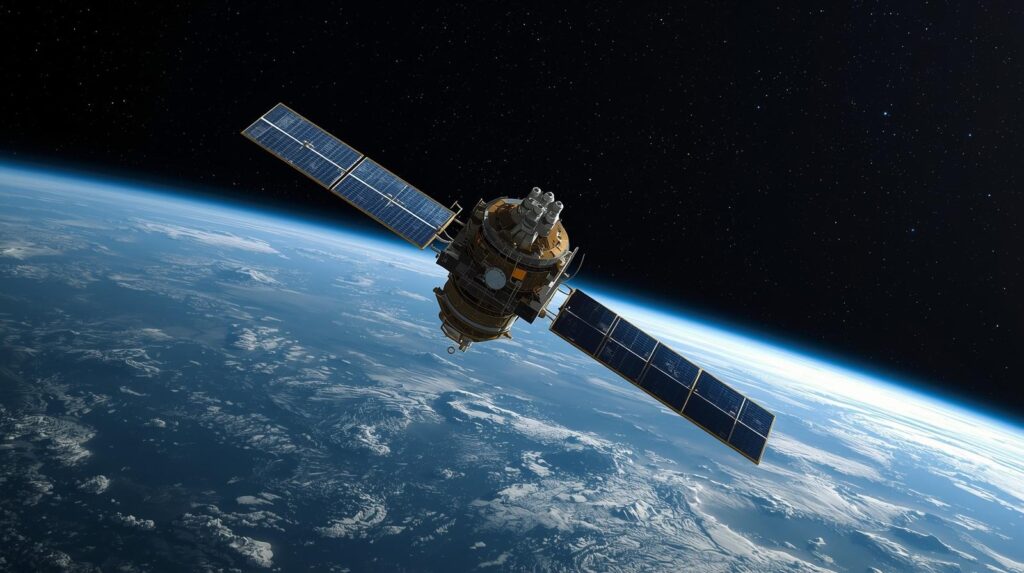The First Observation Satellite: The TIROS-1 Revolution
What Was TIROS-1?
Remember when we didn’t know what Earth looked like from space? That was the 1950s. Enter TIROS-1, the first observation satellite, launched by NASA on April 1, 1960, from Cape Canaveral. It was as if we were giving the Earth its very first selfie camera. This small satellite revolutionized weather forecasting.
Why Was It Needed
At that time, it was like trying to predict the weather by guessing what is inside a wrapped present. There were ground stations and planes, but they couldn’t look over oceans or distant locations. TIROS-1 was NASA’s grand plan to observe clouds and storms from space. It was a pioneering effort to make life safer.
What Did It Look Like?
TIROS-1 was no streamlined spacecraft. Imagine a large drum, roughly three feet in diameter, and 270 pounds heavy. It had 18 sides wrapped with 9,000 small solar cells for energy. Two cameras—a wide-angle and a zoomed-in one—took black-and-white photographs. Simple, yet brilliant.

How Did It Work?
The satellite rotated like a top to remain balanced in orbit. That rotation caused its cameras to sweep back and forth across the Earth, taking pictures when sunlight shone down on the ground below. The pictures were recorded on tape recorders, similar to old cassette tapes, and relayed to ground stations. It circled 450 miles high, following around the poles to capture the entire world.
The First Pictures
The initial picture taken by TIROS-1 was fuzzy, displaying the curve of Earth and a few clouds. Not 4K by today’s standards, perhaps, but groundbreaking in 1960. In 78 days, it provided 23,000 photographs. For instance, it followed a cyclone off Bermuda, providing scientists with a perspective they’d never known existed.
Why It Was a Big Deal
Prior to TIROS-1, weather forecasts were on a hit-or-miss basis. This satellite provided the first actual glimpse of storms brewing over oceans. I believe it’s incredible how it assisted meteorologists in alerting individuals to hurricanes in advance. It’s like receiving an SMS prior to an unexpected test—life-saving.
Real-Life Impact
Farmers loved it. They could check satellite data to know when to protect crops from storms. Think of it like checking your weather app before a picnic. In 1960, TIROS-1 spotted a tornado outbreak in the Midwest, helping warn folks faster than ever.
Comparing Then and Now
TIROS-1 was like the original flip phone—a simple thing, but revolutionary. Today’s satellites, such as the GOES series, are akin to smartphones, streaming color video in real time. The difference is enormous, but TIROS-1 paved the way. Without it, no high-tech weather apps of today.
What Went Wrong?
It wasn’t flawless. TIROS-1 succumbed after 75 days when its batteries expired. Warning: even space technology fails. It remains up there, drifting as space debris. That serves as a reminder—we must clear orbit to prevent subsequent issues.
My Take on It
I am amazed that something so straightforward revolutionized the world. TIROS-1 was a precursor, like the first light bulb—it was not ideal, but it illuminated the path. It indicated that human beings could observe Earth from space, generating ideas about climate and global systems well before they became fashionable.
Tips for Using Satellite Data
If you’re in a stormy area, trust satellite-based forecasts—they’re more accurate thanks to TIROS-1’s legacy. But don’t ignore local reports; satellites can miss small details like sudden wind changes. Check apps like AccuWeather for the latest data.
The Tech Behind It
The cameras were Vidicon tubes, similar to antique TVs, converting light into signals. Solar panels supplied power with batteries for when the satellite was in the shadow of Earth. No nuclear reactors—just sun and brains. It’s crazy how simple technology did so much.
Legacy of TIROS-1
By 1962, TIROS-1’s successors provided us with around-the-clock weather reports. Today, there are hundreds of satellites monitoring storms, blazes, even melting ice. It’s like having a global watchdog. For instance, in Hurricane Andrew in 1992, satellite information saved lives through early evacuations.
Why It Matters Today
Satellite data isn’t just for weather. It helps track climate change, like melting ice caps or deforestation. Airlines use it to avoid turbulence, making flights smoother. Ever had a bumpy ride? Thank satellites for keeping those rare.
A Tip for Students
Interested in space? Explore NASA’s web archives for TIROS-1 photos. They’re free and great for science projects. It’s like discovering a treasure trove of space history. Museums such as the Smithsonian also offer TIROS models to examine.
A Warning About Space Junk
TIROS-1 still circles the earth but is now worthless—just trash. Space trash is increasing, with thousands of outdated satellites in orbit. We must make more effective clean-up plans, or it might interfere with future missions.
FAQs
What was the first observation satellite?
TIROS-1, launched by NASA in 1960.
Why was it significant?
It provided the first space-based observations of weather, leading to forecasts much improved.
Is it still functioning?
Nope, it malfunctioned in 1960 but continues to orbit as space debris.
How is it different from Sputnik?
Sputnik was the first satellite but did not observe Earth. TIROS-1 was designed to observe.
What followed?The TIROS series expanded, then Nimbus and Landsat for weather observation and land observation.
How to Learn More
Feel like geeking out? NASA’s website has TIROS-1 images and information. Go to air and space museums and check out neat displays. It’s like visiting the past and viewing where our weather technology started.
A Real-Life Example
TIROS-1 spotted a developing storm system over the Atlantic in 1960. Meteorologists used those pictures to alert ships and prevent a catastrophe. It’s like how satellite data today assists us with planning around hurricanes.
My Final Thoughts
TIROS-1 was revolutionary. It’s like when you test something new and it performs better than you ever imagined. It made us realize that Earth is one big system, enhanced forecast, and paved the way for loads of tech. That’s cool for a whirling drum in space.
Conclusion
TIROS-1 was a trailblazer that introduced us to Earth from a new perspective. It saved lives, assisted farmers, and launched a technology revolution we continue to depend on. The next time you glance at the weather, offer a small thank-you to that 1960 satellite. It’s still affecting our world. Continue learning about space—it’s full of surprises!
